4 takeaways from Martin Lindstrom’s Live Talk
Yesterday, BRAND MINDS hosted Live Talk with world-famous brand expert Martin Lindstrom to mark the launch of his latest book on organizational culture, The Ministry of Common Sense. This was the first time Martin has spoken about his new book to the public in Romania and we are stoked he chose the BRAND MINDS community.
Of the many valuable insights and recommendations that Martin shared yesterday, I chose four that I believe are more relevant to the current situation.
4 main takeaways shared by Martin Lindstrom during the live talk
1. See the world from your customer’s point of view.
The first rule of writing anything, from mini-copy to long-form content is to ask someone else for feedback.
The person creating the respective piece of content, the author, cannot give feedback. It takes a new pair of eyes to spot tiny mistakes or any other errors that the author just cannot see.
It’s the same with your product. You may believe that your product caters to the needs of your customers perfectly. Or that the buying journey your organization provides is a pleasant experience.
Unless you put yourself in your customer’s shoes, you don’t know that for sure. And once you see the world from your customer’s point of view, you might be in for a big surprise.
You might discover a number of frictions in your purchasing process that you were unaware of.
Here is an excellent example that attracted a lot of attention last year: how many clicks does it take to create a bank account?
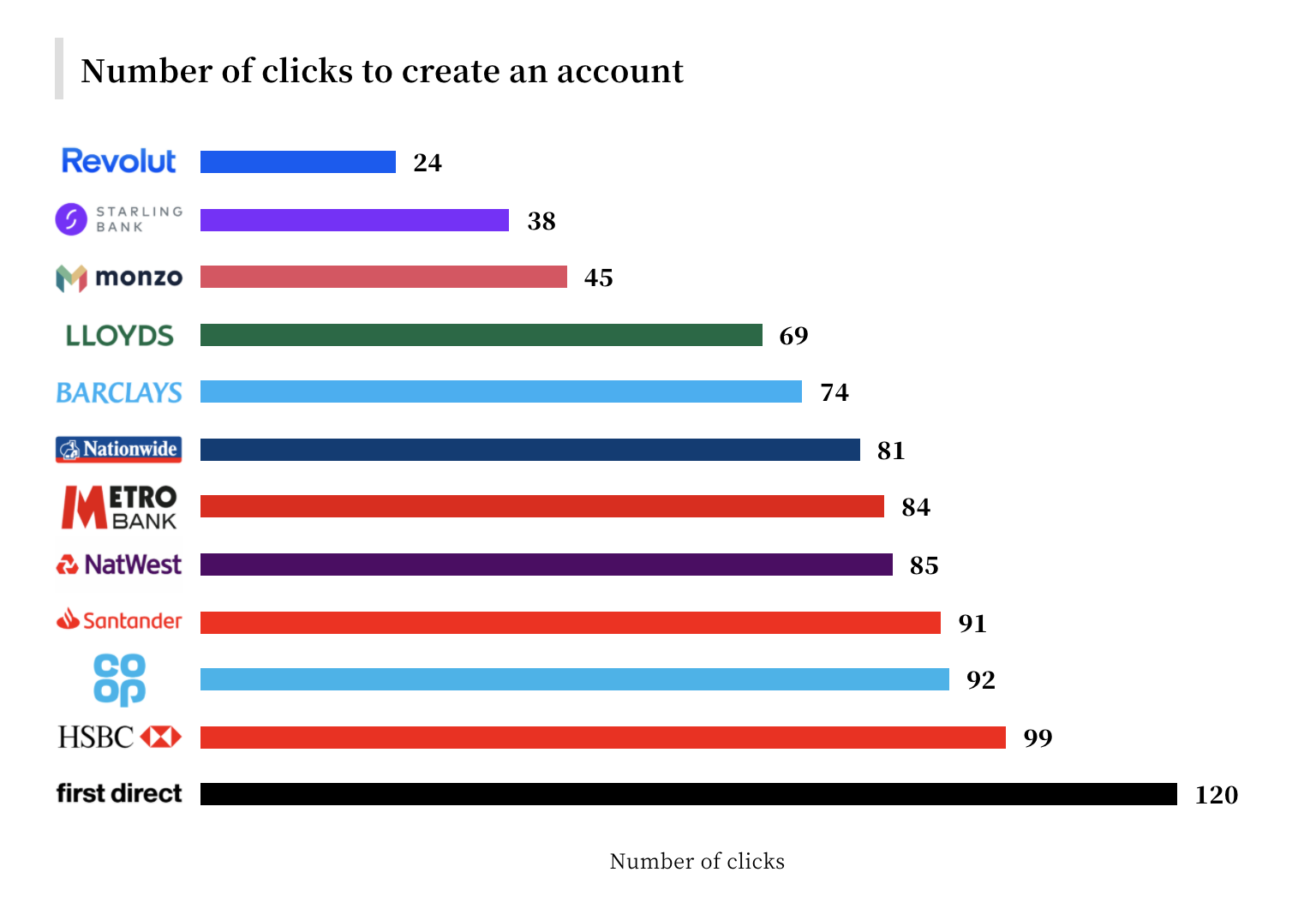
The author of this report opened a bank account at twelve different banks.
Time is a scarce resource. It’s the only resource we cannot make more of. Your customers feel the same too.
Looking at this report, which bank is seeing the world through its customer’s eyes in your opinion? Which bank provides the customer with the highest rate of friction regarding a basic operation like opening a bank account?
I’m certain that First Direct didn’t set out to establish such a time-consuming experience for their customers (120 clicks!). The experience they offer is correct and necessary from their point of view, not their customer’s.
Remember: you are not your customer.
As Martin pointed out yesterday, companies are seeing the world from inside out instead of outside in. We need to see things as they are and do things as they should be. Let’s treat our customers as they should be treated. That means showing empathy. When we show empathy, the happiness levels of our customers increase by 10%.
Empathy is what every person in business will be talking about in the comping years.
Martin Lindstrom
2. Your customer decides what is common sense.
When companies are just starting out, they are based on common sense and empathy.
As companies grow bigger, they shift from common sense to nonsense. A new layer of bureaucracy is added to the mix.
The number of rules increases and operations that were once easy to get done are now getting harder and harder to do. The organization is getting itself ever deeper into a paralyzing situation.
That’s why Jeff Bezos has been ending every one of his letters to shareholders with this phrase: It remains Day 1. Because a Day 1 type of company is nimble and agile while a Day 2 company is a giant that is slow at making decisions.
The organizational culture at Amazon is focused on delighting the customers. You cannot delight your customers if you don’t know what they want or expect from you.
How do you decide what is common sense for your organization?
It’s not up to you to decide.
Your customer will tell you what is common sense. What your organization needs to do is stay close to its customers and allow them to tell you what is common sense.
3. Measure productivity by how happy your customers are.
Since the pandemic changed our routines, more and more people are working from home.
Some organizations have reported an increase in productivity levels with voices saying the 9 to 5 workplace is dead.
Other reports draw attention to the mental health situation of the employees working from home who are experiencing fatigue, exhaustion or burnout.
In today’s world, how do you measure productivity?
Martin suggests a different approach to measuring productivity. Instead of how many Zoom calls we have participated in, let’s measure how happy our customers are.
Let’s measure the levels of employee satisfaction. Or how easy/difficult it is for colleagues to work with us.
We need to get back to making really valuable contributions like strategic thinking and creativity. We need to figure out how to measure creativity through a screen.
Ultimately, what organizations need to do is change their culture. You will never have a better time to redesign your company than now.
If you go through a crisis like this and you haven’t fundamentally changed your business, you didn’t get the message. This is the moment to change your business.
Martin Lindstrom
4. Find frictions in your organization and address them in 90 days.
What is friction in business? Friction is anything that prevents or dissuades customers from buying your products or services.
Take the number of clicks to open a bank account example above. Do customers have the time or patience to open a bank account after clicking 100 times? I know I would give up a few clicks into the whole process.
Now think of your organization. Is there a process that could be completed in fewer steps? Would customers benefit from a shorter purchasing process? Would the company website provide customers with a more pleasant experience if the UX was cleaner and simpler?
The more complex the organization, the more opportunities for frictions to appear.
Martin recommends we make a list of every friction point in our organization and address them one by one in 90 days. We need to remove one nonsense at a time.
If you didn’t join the Live Talk yesterday, you can watch the replay.
Join the Conversation
We’d love to hear what you have to say.
Get in touch with us on our LinkedIn Page, Facebook Page, Twitter or TikTok.
4 Useful Chrome Extensions Every Entrepreneur Needs to Have
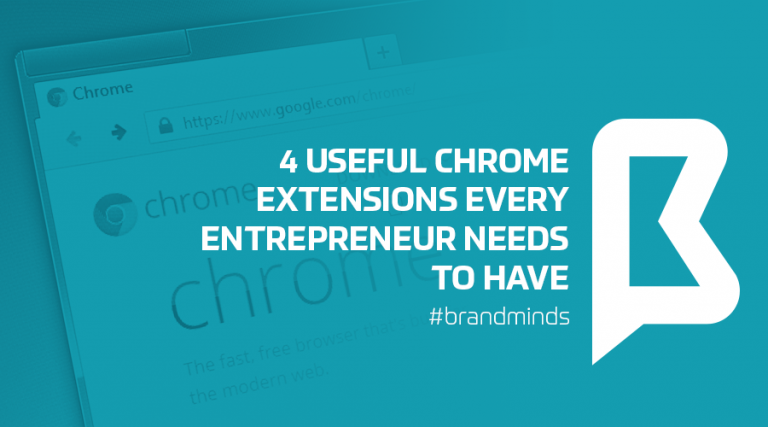
What do all entrepreneurs want?
Get as many tasks done as possible in one day’s work!
But how many entrepreneurs can say they are happy with how they spend most of their time?
These 4 useful Chrome extensions will help you boost your productivity and allow you to use your precious time for business development.
1. Screencastify – Screen recorder

image source: g2crowd.com
Screencastify is a productivity extension. It is a screen recorder: you can record, edit and share videos in seconds. Screencastify has been downloaded by almost 5.830.000 users and has 2.2 million hours recorded in 2017.
Features:
Record
– Desktop, browser tab or webcam capture
– Narrate with your microphone’s audio
– Customize your resolution and FPS
– Embed your webcam into the screencast
Edit
– Annotate your screen with a pen tool
– Focus a spotlight on your mouse
– Crop your recording (Premium)
– Trim your recording (Premium)
Share
– Videos automatically save to Google Drive
– Publish directly to YouTube
– Save and manage videos locally
– Export as .mp4 or animated gif (Premium)
2. Mixmax – Email tracking, Templates, Mail Merge

image source: zazzlemedia.co.uk
Mixmax is also a productivity tool as Screencastify, but it is focused on mail management.
With Mixmax you can reach out more effectively to prospects, clients, and customers.
Features:
– Track opens, clicks, and downloads
– Schedule meetings and plan events
– Write faster with templates
– Personalize bulk emails with mail merge
– Snooze and set reminders
– Send later
– Embed polls and surveys
– Share any email to Salesforce,
Slack, and other services
– Automated web previews of websites and links
3. CloudHQ – Backup and integrate your cloud data

image source: amazon.com
With CloudHQ you can integrate and backup your Google Apps with other cloud services you might use in your company.
Features:
– Sync multiple accounts between cloud services (i.e. Sharepoint ←→ Google Drive, Evernote ←→ Google Drive, etc.);
– Provides a reliable *real-time* consolidation and aggregation of all cloud data;
– Fully integrates all your Google Drive and Gmail accounts with cloud services such as Salesforce, Evernote, Basecamp, Box, Dropbox, Egnyte, OneDrive, Office365, SharePoint, Amazon S3, and more;
– Other cloud services are supported via WebDAV and sFTP.
CloudHQ offers a wide range of features such as send your email to SMS, save emails to PDF, share email as link and other features you can check here.
4. LinkedIn Sales Navigator – Build better relationships

image source: boostdigital.org
LinkedIn Sales Navigator for Gmail is a free and convenient way to build better relationships by surfacing LinkedIn insights about your prospects and customers without having to leave your inbox.
This Chrome extension is available in two flavors, “Lite” for free LinkedIn members, and “Premium” for LinkedIn Sales Navigator subscribers.
Sales Navigator Lite for Gmail will let you:
– See rich LinkedIn profile data for your contacts directly in your Gmail, and use that knowledge when you reach out next;
– Mention icebreakers, including shared connections, experiences, and interests, to build rapport with your contacts;
– Hover over any email address anywhere in your message to quickly view their profile to stay informed on who’s who;
If you have a Sales Navigator subscription, the extension will unlock these additional Premium features:
– Save contacts as leads in your Sales Navigator account;
– Use TeamLink to see if prospects are connected to your colleagues and get a warm introduction.
Gmail versus Outlook: which e-mail provider is better for you? Part II
Last week we started a bigger discussion about the best two free email providers – Gmail and Outlook – and which one might be the best to choose from your business. Now, we continue and elaborate the subject.
5 Advantages of using Gmail
- Productivity– It comes in handy when you are looking to enrich your productivity. Some of its many features is the built-in tasks utility that you can use to send tasks to your Google Calendar.
- Easy usage – The provider is very user friendly. Anybody would get used to it pretty fast.
- Customization– Gmail allows for a great deal of customization. Not only can you control the appearance of the Gmail interface using themes, you can choose the way your inbox works by turning features such as tabs off and on. Also, use color coding and markers to customize how various messages appear.
- Integration– Gmail integrates with a number of other Google tools. There are also many Plugins that expand the capabilities of Gmail even further.
- Community Support– The Gmail help center is well-organized and addresses many questions. Plus, Google maintains a Gmail help forum, where users can ask specific questions.
5 Advantages of using Outlook
- Ease of Use– com is easy to download and use. It has a clean, modern interface that is intuitive and easy to understand.
- Productivity– Outlook has a built-in task tool. You can easily access the calendar from within your inbox by clicking the Calendar icon and without leaving your inbox.
- Customization– As with Gmail, you can use themes to change the appearance of your interface. You can make some limited changes to the way that your inbox works, such as choosing where the reading pane appears and choosing to show or hide preview text.
- Integration– it integrates with other Microsoft tools. You can use the grid in the upper left of the inbox to open other Microsoft tools. There are also many add-ins that expand your email capabilities. You can add them from within your inbox using the Manage Integrations option.
- Community Support– Outlook for MS Office is widely acknowledged as the standard in many corporations. Outlook.com also has a user community. Plus, there are many helpful third-party articles and tutorials written that can help you anytime.
Ultimately, choosing your email provider is a very intimate decision and it must be based on your work and personal preferences. A free email service like Gmail or Outlook.com can be a good choice for you or your small business.
Before finalizing your choice of email providers, it’s important to ask yourself what you really need from your email service, address the main important questions regarding your type of business, dimension, usage, security, how many people will be accessing it, etc. The email service you choose depends on how you use your email and what you need from it. If you approach the decision carefully and make an informed choice, the email provider you choose is likely to be the best email service provider for you.
In other words, no matter how many pieces of advice you receive, the decision belongs to you. Because while some consider Outlook to be an upgrade from Gmail, others still see Gmail as the king of the free email providers.
Here is an opinion about why leaving Outlook for Gmail, while here, an opinion in reverse.
Decided? What will you choose?
To multitask or not? This is the question
When I was little, my parents taught me to do one thing at a time and do it the best possible. Not trying to start ten projects or jump from one thing to another without finishing what I began first. Although I’ve always had the internal push to do several things at one time, I kept remembering their advice and trying to stick to it. As much as possible. Back then, the idea of multitasking wasn’t around and known to us, but I believe they were right. And recent studies seem to back them up as well.
According to Larry Kim, Founder and CTO WordStream, our brains are designed to focus on one thing at a time, and bombarding them with information only slows them down. MIT neuroscientist Earl Miller notes that our brains are “not wired to multitask well… when people think they’re multitasking, they’re actually just switching from one task to another very rapidly. And every time they do, there’s a cognitive cost.”
This constant task-switching encourages bad brain habits. When we complete a tiny task (sending an email, answering a text message, posting a tweet), we are hit with a dollop of dopamine, our reward hormone. “Our brains love that dopamine, and so we’re encouraged to keep switching between small mini-tasks that give us instant gratification. This creates a dangerous feedback loop that makes us feel like we’re accomplishing a ton, when we’re really not doing much at all (or at least nothing requiring much critical thinking). In fact, some even refer to email/Twitter/Facebook-checking as a neural addiction,” said Larry Kim for inc.com.
As shown by Marketing Week, Academics at Vanderbilt University found evidence in 2006 that the brain’s frontal lobe creates a “bottleneck of information processing that severely limits our ability to multitask”. The proliferation of media channels and devices makes this worse. Another study, published by Stanford University researchers in 2009, found “heavy media multitaskers are more susceptible to interference from irrelevant environmental stimuli and from irrelevant representations in memory”. And this hampers the ability to switch between tasks.
We can shift our focus really fast, sometimes it takes just a 10th of a second. But the time doesn’t matter as much as the bandwidth the brain requires to move back and forth. Now that might affect your performance, and might also affect the quality of the work that you finally produce.
New research suggests the possibility that cognitive damage associated with multi-tasking could be permanent.
A study from the University of Sussex (UK) ran MRI scans on the brains of individuals who spent time on multiple devices at once (texting while watching TV, for example). The MRI scans showed that subjects who multitasked more often had less brain density in the anterior cingulate cortex, the area responsible for empathy and emotional control. Unfortunately, the research isn’t detailed enough to determine if multitasking is responsible for these affects, or if existing brain damage results in multitasking habits.
Moreover, there have been studies that show women are generally better at multitasking than men. Also, people who thought they were the best at multitasking are almost always in fact the worst. In fact, multitasking seems to be something not all of us are truly able to achieve, as only about 2% of the population is formed of super multitaskers (people who are truly able to do several different activities at the same time without losing efficiency or losing quality as they do all that work). Most of us don’t have this gift.
According to Forbes, the problem with trying to multi-task is all that shifting back and forth between tasks isn’t all that efficient because, each time we do it, it takes our brain some time to refocus. So while it might seem efficient on the surface, it isn’t – studies show that multi-tasking can reduce productivity by as much as 40%.
More than that, a study published by the American Psychological Association concluded that the ability to switch between tasks, which they term, “mental flexibility” generally peaks in the 20s and then decreases with age, in average of 30.9% from a person in their 40s to a person in their 70s. The extent to which it decreases depends upon the type of tasks being performed. The information is back up by another study, this time around conducted on UK soil, at the University of London where the results have shown that the participants who multitasked during cognitive tasks, experienced an IQ score decline similar to those who have stayed up all night. Some of the multitasking men had their IQ drop 15 points, leaving them with the average IQ of an 8-year-old child.
Best Apps for Productivity in 2017
Every day we are bombarded by tons of emails, information and social media that is really hard to keep track of what is truly essential or not. Moreover, they are eating up a lot of precious work time, preventing one from being as productive as it could be and leaving the office at the right hour. Therefore, taking all this context in consideration, all the major app and technology providers are constantly looking for ways of improving the productivity and helping you have a proper balance work-life. We selected some of the most interesting and useful apps and extensions out there on the market, that are ready to help you achieve the productivity goal.
This browser extension measures your time. Being successful means being brutally honest with how you spend your time. You can set a timer for each activity you do and label what you are doing. At the end of the day, you can check how long you spend on each activity and adjust from there. It also syncs in with other productivity apps like Asana. Harvest’s powerful reporting gives you real-time access to keep your projects on time and on budget. Get the insight you need to estimate future projects, and ensure your business’s profitability.
Workflow lets you customize your phone so that you can skip time-wasting tasks. By telling your phone what to do when it notices a certain action, you can instruct your phone to call a taxi before your next calendar appointment, upload your latest photo to Instagram, and any other string of actions you can think of. You can build your own workflows with a simple drag-and-drop interface. Mix & match hundreds of actions to create quick shortcuts, manage your media, share content, and much more.
Under the headline, “Remember everything”, Evernote is an online collection of everything you want to remember. It’s like a digital notebook that stores photos, web pages, notes, PDF files, audio clips, and to-do lists. Once you add things to your notebook they’re completely searchable and can be accessed on your desktop, the Web, or your mobile device.

It allows you write and store documents, sketches, memos, pictures, and more online through the cloud. You can access it on your phone or on a computer. It proves to be very useful, especially when you have long materials or analysis to write, as you can start on your phone and continue the work at your laptop or desktop and vice-versa.
Moreover, Evernote makes sure the notes you’ve saved are easy to find. You can even search for handwritten words buried deep within your notes.
Slack is a great way for keeping in touch with your team at work without sifting through dozens of emails. You can tag users and create multiple channels for smaller team projects. The desktop client sends nonintrusive desktop notifications to the corner of your screen, allowing you to stay on top of what’s happening while keeping your eyes on your work.
When you are loaded with emails and you need order, Slack solves this by being something in between email and instant message. Messages and files sent to a group of people or a single person are neatly organized and clear as day.
On top of that, there are customizations you can add to make it your own. You can have it alert your phone with the app or pull up a GIF if you’re feeling funny.
If you want clear and easy, Clear is one of the simplest ways to keep track of what you need to do. You can easily drag and reorder your to-dos, and adding a new item is as easy as pulling down your list and typing it in. When you’re done with a task, just swipe right.
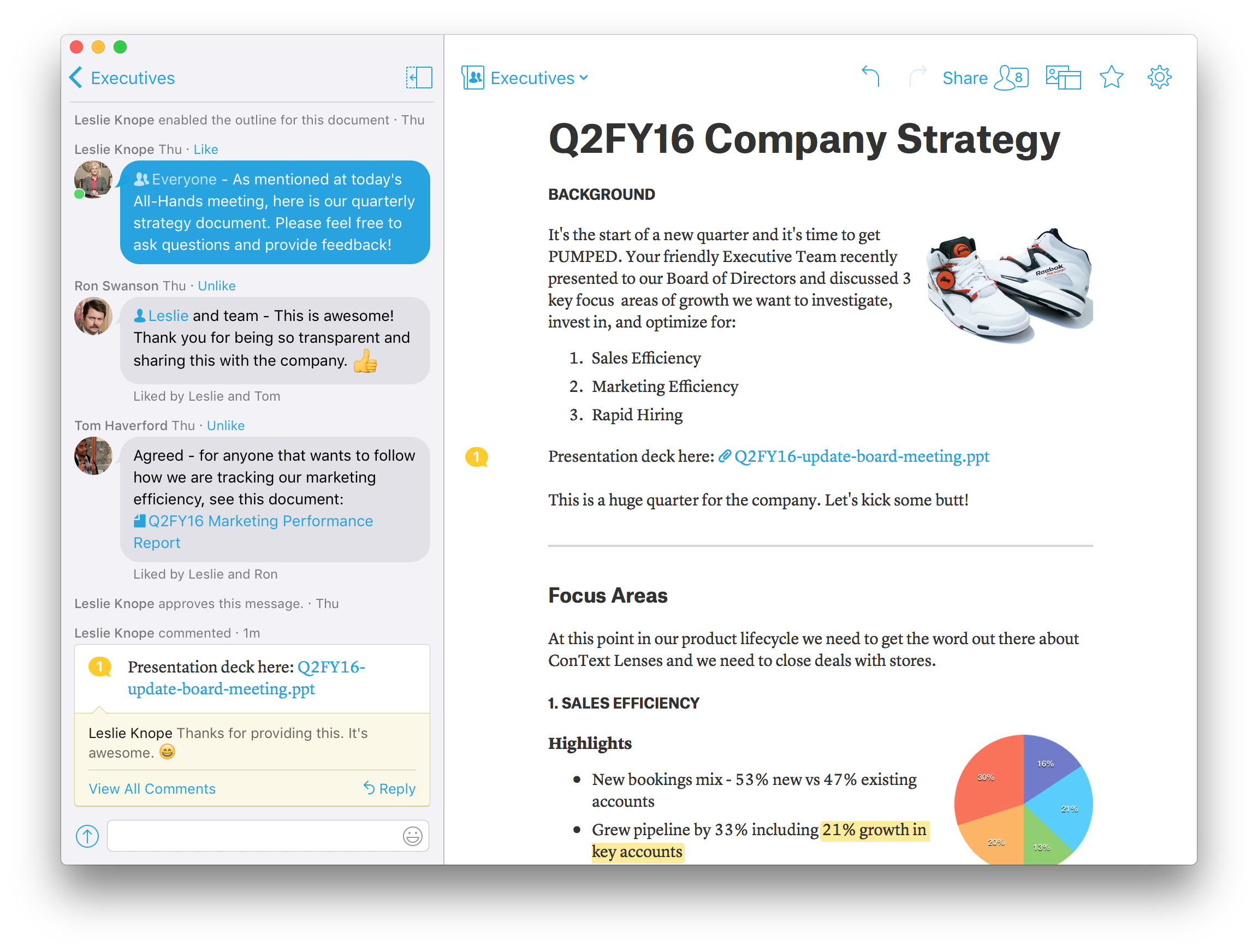
Quip is a mobile word-processing app created by Facebook’s former chief technology officer, Bret Taylor. Quip infuses a messaging element into the app to make collaboration a breeze. You can use the app to create documents, spreadsheets, and presentations. You can also use the app to collaborate on blog posts, manage projects, or even share a grocery list. Photo source: https://www.g2crowd.com/products/quip/details
According to thenextweb.com, if you find yourself bombarded with cute videos all day, Pocket might help you save those for later. If you frequently come across things you’d like to read “at some time” then Pocket can, again, help you out. With the requisite bookmarks, apps and extensions, it’s easy for you to save stuff to check out whenever you like.
The service lets you bookmark anything on the Web; articles are stored in your personal library, where they can be easily located and read when it’s most convenient. It doesn’t matter if you have a connection either, as Pocket can download (almost) everything to your device automatically.
Google Keep is a bit like Google’s version of Evernote, and it’s now available on both iOS and Android. You can use the app to take notes, make to-do lists, set reminders, and record audio. And one of its main qualities is the ability to organize your notes with colored labels.
Moreover, it’s stored online, so if you lose your phone or computer, your information is safe. It’s also accessible anywhere with Internet access. It’s intentionally made to be a very simple platform with few options. Therefore, you cannot format your text in any way.
Wunderlist is an easy-to-use to-do list app. It lets you set due dates and reminders and share lists or have conversations about them. Wunderlist can help you organize your grocery list, remember movies you want to see, or collaborate to help plan a vacation.
Besides keeping you organized, Fantastical 2’s best feature lets you enter simple phrases, which it will then translate into a calendar appointment automatically. Even better, the DayTicker and the event list are connected. Swipe the list and the DayTicker will update automatically. Fantastical lets you see your events and reminders like never before.
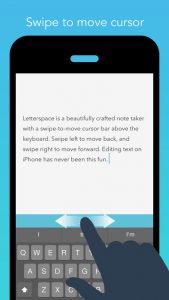
Letterspace is a note-taking app that uses hashtags to organize your thoughts. It also has a handy swipe bar that lets you move your on-screen cursor without moving your hands from the keyboard, which makes editing your notes much easier. Letterspace doesn’t distract you. It provides a noise free space to jot things down. To create a To Do List start a new line with a dash and a pair of squared brackets. On iPhone & iPad, Letterspace smart symbol suggestion also presents these characters when you start a new line. To mark it as completed just tap on it like a checkbox. Use #hashtag and @mentions anywhere in your notes. Letterspace automatically indexes and groups them together. In case you forgot to tag, we also have Full-Text search that support Asian languages right from the start.
The Internet is filled with interesting, crazy and new information (and sometimes so much we cannot handle it all). Driven by curiosity and personal development, you can spend a lot of time at work reading trivial articles. If you want to fix this, Instapaper is worth looking at. With one click, you can save it to be read later. It also suggests topics and articles through what you have saved already. Instapaper syncs the articles and videos you save so that they’re waiting for you on all your devices – iPhone, iPad, Android, or Kindle. You can read anything you save, anywhere and anytime you want, even offline.
- Time Tracker
This extension does what it says as well: it tracks your time. What’s great about this one is that it logs every different website you go to. You can check it out in detail to see where you spend your time. You will be surprised sometimes how much a certain website sucks your time and adjust.
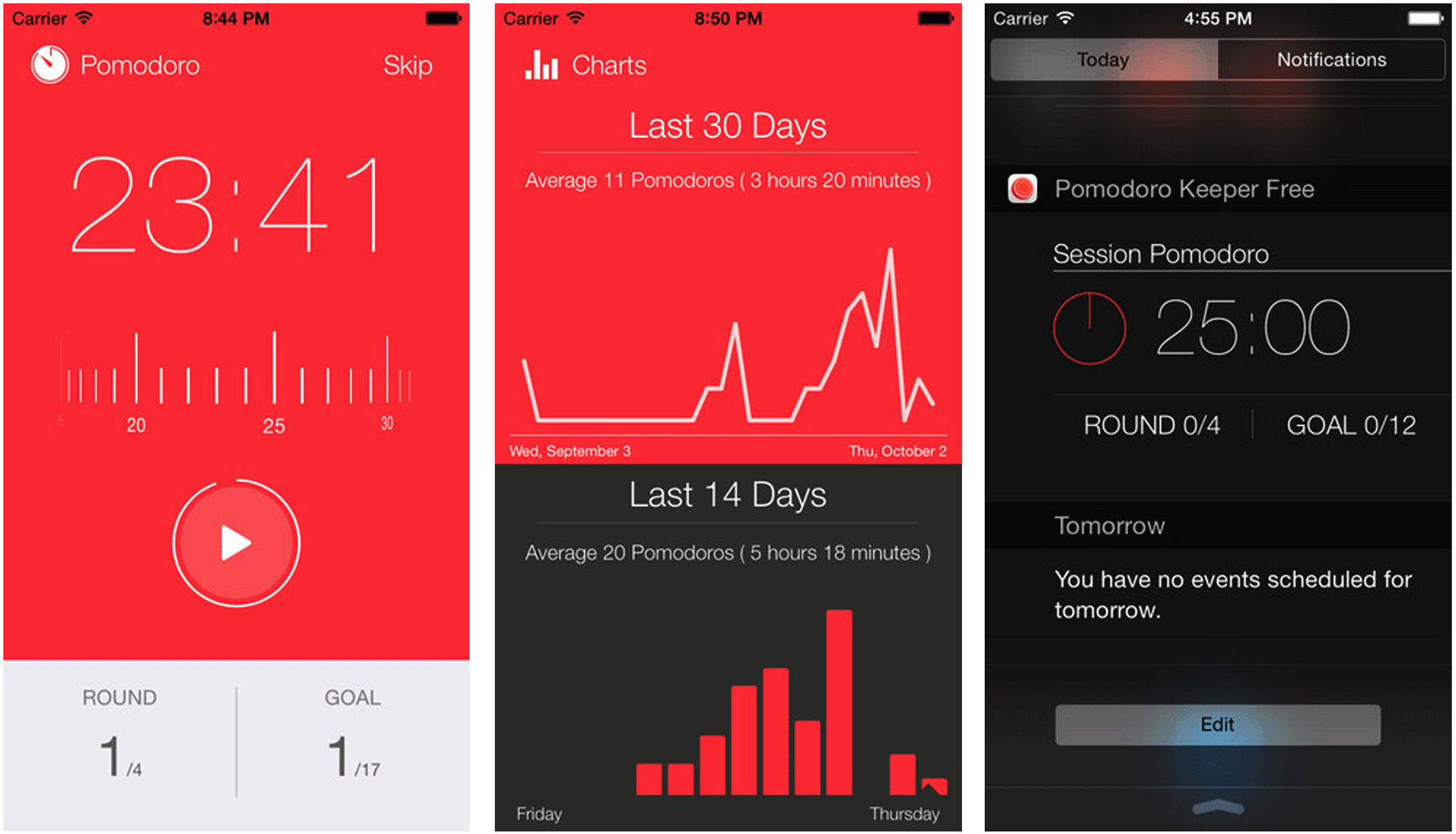
One of the most well-known productivity techniques is the Pomodoro Technique. Basically, you focus on just one task for 25 minutes and then take a forced 5-minute break. This extension is just like the Forest App but there is no animated tree involved (just a timer). Photo source: https://zapier.com/blog/best-pomodoro-apps/
Have you ever wondered if you are being less productive than you could be because you don’t know much about the science of sleep or sleep cycles? If not, it’s true. This site solves this problem for you by letting you know when you should sleep and wake up based on your personalized sleep cycles. If you don’t like this one, there are plenty of other tools and apps that do similar tasks. Sleep is a crucial, but often overlooked part of everyone’s life. Having the right amount can literally double your productivity.


